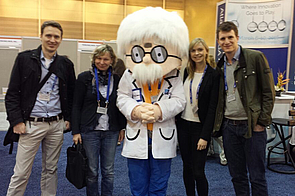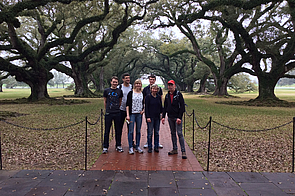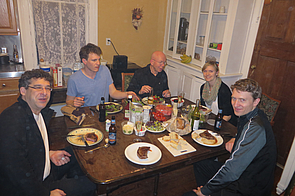PittCon, March 2015, Ernest N. Morial Convention Center New Orleans, LA USA
Conferee Networking, Facilitator: W. Miekisch
Non-Invasive Biomedical Analysis – Effects of Environmental VOCs
Volatile organic compounds (VOCs) may act as potential biomarkers for diseases such as cancer, diabetes or infections. A major part of more than 800 VOCs detectable in the breath is meant to come from environmental sources rather than from biochemical processes in the body. This session will continue the tradition of successful Pittcon networking on non-invasive biomedical analysis from 2010-2014. Focusing on impact of environmental related compounds, exogenous VOCs as confounding factors as well as potential applications of e-VOCs will be discussed:
How do environmental loads influence potential biomarker sets?
Can exogenous compounds be used as biomarkers?
How can high resolution analytical techniques (e.g. GCxGC-TOF, PTR-TOF) help us to unravel effects of the environment?
Adverse Outcome Pathways (AOPs) in Human Systems Biology: In Vivo Discovery for Developing In Vitro Target Methods
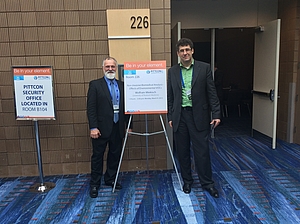
Organizers
Joachim D Pleil, US EPA and Wolfram Miekisch, University Hospital of Rostock
This symposium explores different approaches for measuring biological chemicals from in vivo analyses and linking forward to in vitro methods that could be amenable for high-throughput testing. Analytical methods covered will include gas-phase metabolomonics, molecular level immunochemistry, mid-infrared tunable diode lasers measurements, and nanoscale liquid chromatography - mass spectrometry.
Titles
8:30 AM Introductory Remarks
8:35 AM Adverse Outcome Pathways (AOPs) in Human Systems Biology: Gas-Phase Probes for Assessing In Vitro Enzyme System Perturbations
9:10 AM Real-Time Mass Spectrometry for Rapid Throughput in Adverse Outcome Pathways Assessments
9:45 AM Personalized Medicine Using Mid-IR Spectroscopy: Fact or Fiction?
10:20 AM Recess
10:35 AM Systems Toxicology of Environmental Metals: Identifying Key Molecular Pathways Linking Environmental Exposure with Disease
11:10 AM Nano-Scale Fingerprinting of Human Blood Protein Adducts for Exposure Assessments
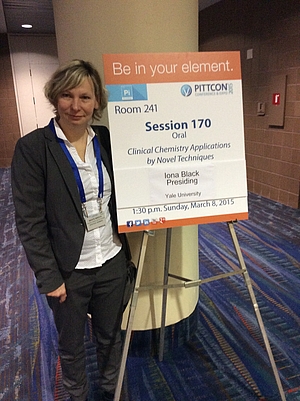
Oral Sessions
| Author Name: | Beate Brock - University Medicine of Rostock |
| Session Title: | Clinical Chemistry Applications by Novel Techniques |
| Event Type: | Oral Sessions |
| Event Title: | Continuous Monitoring of Volatile Organic Compounds (VOCs) in the Breath of Mechanically Ventilated Patients by Means of Proton Transfer Reaction Time-of-Flight Mass Spectrometry (PTR-ToF-MS) |
| Presider Name: | Iona Black | Co-Author: | Svend Kamysek, Phillip Trefz, Josephine Silz, Wolfram Miekisch, Jochen K Schubert |
| Affiliation: | Yale University | Affiliation: | University Medicine of Rostock |
| Date: | Sunday, March 8, 2015 |
| Start Time: | 14:30 (Slot #4) |
| Location: | 241 |
Abstract Content
| In critically ill patients, life-threatening changes of vital conditions may occur within seconds. Some of these changes translate into breath VOC profiles. Non-invasive real time monitoring might become possible when breath resolved determination of VOCs could be realized through direct mass spectrometry. Breath from 12 mechanically ventilated patients was analyzed continuously by means of PTR-ToF-MS during one hour immediately following cardiac surgery. For safety reasons, a 6m long heated silicosteel transfer line was used for breath sampling. Through optimization of operational parameters a time resolution of 200ms could be realized for PTR-TOF measurements. Thus, breath resolved detection of more than 300 mass traces was possible without interference with mechanical ventilation and without need of additional equipment. Identification of alveolar and inspiratory phases was performed by a custom-made algorithm. Detection limits (for continuous monitoring) were in the low ppbV / high pptV range. Exogenous contaminants (anesthetics, disinfectants) could be identified by comparison of breath phases. Analyzing specific markers, representing aspects of metabolism (acetone), cardiac output dependency (isoprene) or oxidative stress (aldehydes) we were able to monitor (patho)physiological processes non-invasively. During a lung recruitment maneuver isoprene concentrations decreased by 52% whereas PCO2 only decreased by 13%, acetone decreased by 26%. After lung recruitment acetone had decreased by 14 %, whereas isoprene and CO2 increased by 4% and 9%. Continuous VOC monitoring by PTR-TOF enables immediate recognition of physiological or therapeutic effects in ICU patients. In a perspective non-invasive real-time monitoring of breath biomarkers may act as tool to observe patients’ clinical conditions. |
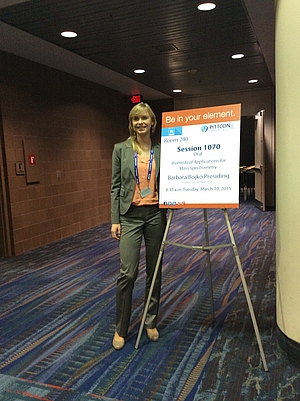
Oral Sessions
| Author Name: | Juliane Obermeier - University Medicine of Rostock |
| Session Title: | Biomedical Applications for Mass Spectrometry |
| Event Type: | Oral Sessions |
| Event Title: | Real-Time Mass Spectrometry for Non-Invasive Monitoring of Chronic Kidney Disease in Children |
| Presider Name: | Barbara Bojko | Co-Author: | Josephine Happ, Phillip Trefz, Jochen K Schubert, Hagen Staude, Dagmar C Fischer, Wolfram Miekisch |
| Affiliation: | University of Waterloo | Affiliation: | University Medicine of Rostock, University Medicine Rostock |
| Date: | Tuesday, March 10, 2015 |
| Start Time: | 09:30 (Slot #4) |
| Location: | 240 |
Abstract Content
| In children, non-invasive breath analysis is attractive, since invasive methods such as biopsies or repeated blood collection cause increased risks. Some of the 800 substances detected in human breath have already been described as potential biomarkers of physiological and pathological processes. Direct mass spectrometric techniques, such as proton-transfer-reaction time-of-flight mass spectrometry (PTR-ToF-MS) allow direct and time-resolved analysis of substances in the ppbV to pptV range. In this study, breath gas of pediatric patients with renal diseases (n = 60), such as haemolytic uremic syndrome or kidney dysplasia, and healthy pediatric controls (n = 60) was analyzed by means of PTR-ToF-MS. Alveolar phases of exhalation were identified through breath resolved MS analysis. More than 100 VOCs were detected in the breath of nephrological patients and controls. Data were analyzed by means of PCA and subsequent statistical testing. Isoprene concentrations were higher in nephrological patients (105 ppb vs 72 ppb) potentially reflecting hemolysis in kidney disease. Median pentanal and 2-butanone concentrations were elevated in nephrological patients (10.0 ppb vs 5.8 ppb and 0.99 vs 0.59, respectively) mirroring increased oxidative activity in renal disease. Concentrations of exogenous toluene were significantly higher in nephrological patients (1.8 ppb vs 1.1 ppb) probably indicating contact with medical equipment. In contrast, gender did not make any difference. Breath biomarkers indicate differences between nephrologically ill and healthy children. Non-invasive breath tests may help to understand basic mechanism of the disease and in a perspective allow monitoring and tailoring therapy in pediatric patients. |
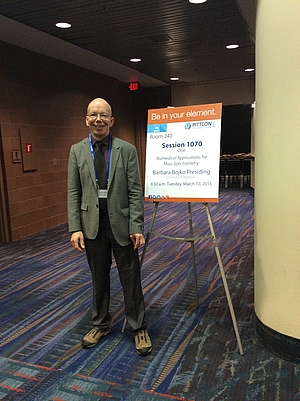
Oral Sessions
| Author Name: | Pritam Sukul/Jochen K. Schubert - University Medicine of Rostock |
| Session Title: | Biomedical Applications for Mass Spectrometry |
| Event Type: | Oral Sessions |
| Event Title: | Real-Time PTR-TOF-MS Measurements Reveal Effects of Patient’s Body Positions onto the Composition of Exhaled Breath |
| Presider Name: | Barbara Bojko | Co-Author: | Phillip Trefz, Wolfram Miekisch |
| Affiliation: | University of Waterloo | Affiliation: | University Medicine of Rostock |
| Date: | Tuesday, March 10, 2015 |
| Start Time: | 11:05 (Slot #9) |
| Location: | 240 |
Abstract Content
| Breath VOC biomarkers (BVOCs) hold promise as noninvasive diagnostic tools of the future. Concentration of BVOCs may depend not only on biochemical or pathologic processes but also on physiological maneuvers. As breath sampling may be done in different body positions, we investigated the effect of the sampling position onto BVOC concentrations by means of real-time mass spectrometry. An online PTR-ToF-MS was used in 15 healthy subjects for breath resolved measurements with parallel monitoring of hemodynamic parameters and pET-CO2. Paced breathing (12/min) for a total of 8 minutes in a series of different body positions (sitting, standing, lying and sitting again) was applied. Each position was held for two minutes. PTR-ToF-MS 8000 in a continuous side stream mode (sampling flow: 20ml/min, time resolution: 200ms) was used. VOCs were quantified in inspired and alveolar air by means of a custom made data processing algorithm. Normalized mean concentrations of isoprene, furan and acetonitrile decreased by 24%, 26% and 9%, respectively, during standing and increased by 63%, 36% and 10% during lying mirroring time profiles of stroke volume and pET-CO2. In contrast, acetone, benzene (exogenous) and H2S (originating from oral bacteria) concentrations remained almost constant. During analysis in the final sitting position, all concentrations returned to initial values. Exhaled blood borne BVOC concentrations changed due to body postures. Changes depended on cardiac stroke volume, on origin and physico-chemical properties of the substances. Patients’ positions and cardiac output have to be controlled when concentrations of breath VOCs are to be interpreted in terms of biomarkers. |
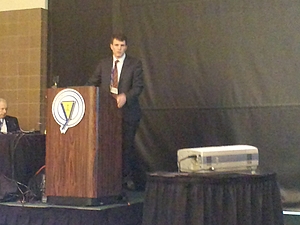
Oral Sessions
| Author Name: | Markus Steffens - University Medicine of Rostock |
| Session Title: | MS for Bio-Analysis |
| Event Type: | Oral Sessions |
| Event Title: | Detection of VOC-Patterns Emitted From Mycobacterial Cultures by Micro-Extraction-Techniques and GC-MS |
| Presider Name: | Robert W Baudoux, Sr. | Co-Author: | Andreas Bergmann, Sina Fischer, Petra Reinhold, Heike Koehler, Jochen K Schubert, Wolfram Miekisch |
| Affiliation: | RWB Convention Mgt | Affiliation: | University Medicine of Rostock, Friedrich-Loeffler-Institut |
| Date: | Tuesday, March 10 2015 |
| Start Time: | 09:30 (Slot #4) |
| Location: | 269 |
Abstract Content
| Mycobacterium avium spp. paratuberculosis (MAP) is the causative agent for Johne’s disease, an intestinal infection in ruminants, which results in economic losses of at least 200 million US-dollars per year. Fast diagnostic of MAP infection is difficult because of slow growth of the pathogen. This study was intended to detect MAP specific patterns of volatile organic compounds (VOCs) in headspaces over in vitro cultures by means of two different micro-extraction techniques. 239 cultures from three different MAP-strains, grown on five different media, were examined. VOCs were extracted from headspace (20mL) of in vitro cultures by means of bidirectional needle-trap-micro-extraction (NTME, 160 samples), or solid-phase-micro-extraction (SPME, 79 samples), respectively. GC-MS was used to identify and quantify extracted VOCs. 113 VOCs, alcohols, alkanes, alkenes, aldehydes, ketones, sulfides, esters, furans and aromatic compounds were detected in ppbV-/high-pptV-levels. 51 of 96 substances detected through NTME and 18 of 82 substances detected through SPME had significantly different concentrations in cultures compared to blank media. Specific VOC patterns could be attributed to different MAP strains and to density of bacterial growth. 17 VOCs were only detected by means of SPME and 31 VOCs only by NTME. 13 of the differentiating VOCs were found by means of NTME and SPME. VOCs emitted from MAP cultures revealed characteristic patterns. As sensitivity can be improved by increased sampling volume, NTME is better suited for comprehensive VOC-profiling. For some substances, SPME provided additional information. Smart combinations of micro-extraction and GC-MS can be used to detect and characterize mycobacterial growth in cultures. |
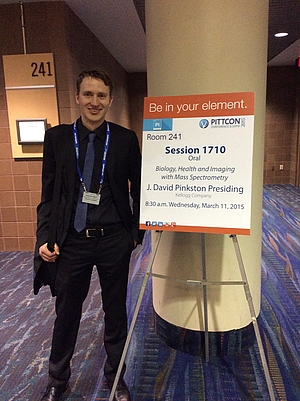
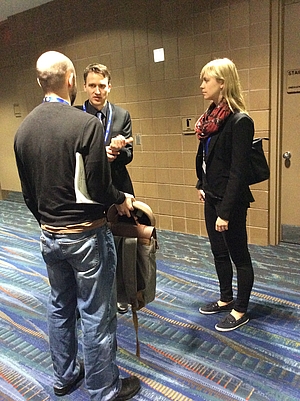
| Author Name: | Phillip Trefz - University Medicine of Rostock |
| Session Title: | Biology, Health and Imaging with Mass Spectrometry |
| Event Type: | Oral Sessions |
| Event Title: | Effects of Humidity on Breath VOC Biomarker Analysis in PTR-ToF-MS Studies |
| Presider Name: | J David Pinkston | Co-Author: | Jochen K Schubert, Wolfram Miekisch |
| Affiliation: | Kellogg Company | Affiliation: | University Medicine of Rostock |
| Date: | Wednesday, March 11, 2015 |
| Start Time: | 10:25 (Slot #7) |
| Location: | 241 |
Abstract Content
| Proton-transfer-reaction-time-of-flight-mass-spectrometry (PTR-ToF-MS) is a powerful tool for real-time analysis of VOC profiles in breath. Time resolutions as low as 200 msec and detection limits in the pptV-ppbV range enable breath-resolved measurements in mechanically ventilated and spontaneously breathing patients. The high water content in breath samples however can have a distinct impact on the quantification. The objective of this study was therefor to systematically investigate the effects of humidity on the quantitative detection of breath VOCs and the adequacy of standard data processing algorithms applied in PTR-MS. More than 20 VOCs (hydrocarbons, ketones, aldehydes and aromatics) were investigated in different trace concentrations (2, 5, 10, 25, 50 and 100ppbV) and different amounts of humidity (0, 1, 25, 50 and 100% rel. humidity). Further, normalization of data onto primary ion count and normalization onto primary ion count in combination with watercluster ion count was tested. Measured intensities of VOCs varied up to 40% when water content was varied, while variation was less than 5% when water content was kept constant, independent of the total amount of water in the sample. Normalization onto primary ions reduced the variation for aldehydes (from 40 to 32% for heptanal e.g.), but increased it for aromatics (from 8 to 15% for toluene). These effects were even more pronounced when watercluster was included in the normalization process. Quantification of biomarkers thus can be compromised if matrix effects like humidity are neglected. Hence, adapted calibration mixtures are mandatory for the reliable quantification of humid samples in real-time PTR-ToF-MS measurements. |
Social Events

